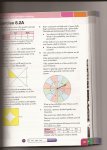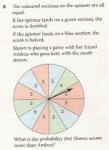The question is no. 6 on this page: ( hope you can read it-have had trouble getting files accepted so use low resolution, maybe too low!)

I might be misinterpreting the wording of the question which seems somewhat 'polysemic' to me!
The circle is divided into 12 segments with 5 Pink 4 Blue and 3 green.
As it is the first go of the game there is no score as yet so I wasn't sure whether , on a first go, the green numbers are doubled. If they are, then all the greens will produce a score higher than three with a theoretical probability of 3/12 (1/4). If the scores aren't doubled on the first go ( or halved in the case of blue) then then it is still 1/4.
Yet the answer is 1/6 which I don't get as each go will have the same probabilities.
I know I'm missing something obvious that will cause me to go 'D'oh!', slap my forehead and think of myself as a no-hoper extraordinaire-so sock it to me!

I might be misinterpreting the wording of the question which seems somewhat 'polysemic' to me!
The circle is divided into 12 segments with 5 Pink 4 Blue and 3 green.
As it is the first go of the game there is no score as yet so I wasn't sure whether , on a first go, the green numbers are doubled. If they are, then all the greens will produce a score higher than three with a theoretical probability of 3/12 (1/4). If the scores aren't doubled on the first go ( or halved in the case of blue) then then it is still 1/4.
Yet the answer is 1/6 which I don't get as each go will have the same probabilities.
I know I'm missing something obvious that will cause me to go 'D'oh!', slap my forehead and think of myself as a no-hoper extraordinaire-so sock it to me!

